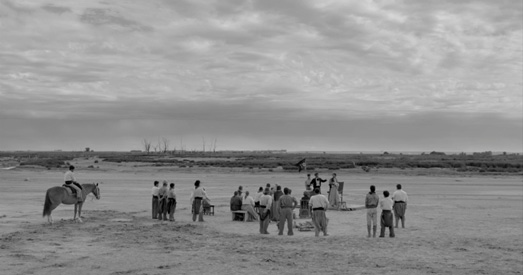“El Movimiento” is a stark black-and-white examination of military political actions and the dark, twisted realities of war. Set in Argentina in 1835, the movie begins with a poor man selling pastries, who is abused by soldiers and eventually gruesomely executed under the orders of a uniformed leader.
Although most of the film emphasizes close-ups, the murder of this man, meant to become a cautionary tale for all the people of the countryside, is filmed at a distance. A flag is shown, but it is not one I’m familiar with. After the initial murder, we follow another leader, Señor (Pablo Cedrón), as he and his companions meet and recruit or murder men in rooms so dark that the walls are unseen.
Written and directed by Benjamín Naishtat, “El Movimiento” or “The Movement” takes place after the defeat of the Spanish and during the civil wars. Historically, Juan Manuel de Rosas was elected governor of the Buenos Aires province in 1829 was in power in the 1830s. Rosas was eventually replaced by another provincial governor, José de Urquiza, in 1851. It is during Rosas’ tenure that Great Britain seizes the Falklands. Yet this is merely background that an Argentine audience would know and that Naishtat does not explain.
Naishtat also doesn’t explicitly say which side we are on or what the movement is. The leader tells peasants, “The Movement is clearly defined and knows that the road to save the nation doesn’t offer numerous alternatives. Gentlemen, our path is full of hypocrites and traitors, of spies, of black shadows and agent of chaos whose only objective is capturing all our efforts and also to disorient us. Confuse us and to own all the things we have conquered with our sacrifice.” He then exhorts the peasants to “cleanse and recover the purity of our cause.”
For those who know modern Argentine history beyond the musical “Evita” or the 1982 Falklands war, there seems to be a powerful subtext about more contemporary issues. Many of the Argentines alive now have memories of the military junta that rose to power in 1976. During the so-called “Dirty War” over tens of thousands were tortured, raped and murdered.
Reminders of those days exist today in Buenos Aires. During my recent trip there, what one fellow tourist thought was an excavation of some sort were actually markers and memorials of those military murders, the people forced to disappear, the Desaparecidos. The topic surfaces in Carlos Saura’s 1998 “Tango” where we are told that tangos were played while men and women were tortured. The 1968 opera “María de Buenos Aires” was reset during the time of the “Dirty War” for the 2012 production by the Long Beach Opera in California and Maria becomes one of the Desaparecidos.
In “El Movimiento,” as the leader speaks to the “gentlemen,” Naishtat’s camera focuses instead on the faces of the women and the thought of the activist group, Mothers of the Plaza de Mayo, comes to mind. By using the civil wars of the 1800s and shooting in black-and-white, Naishtat provides some emotional distance to discuss both the more recent legacy of military juntas and the distressing repetition of history.












